13 Shoulder Stability, Arm and Hand Strengthening Exercises for Children with Down Syndrome
Children with Down Syndrome are often hypermobile, which means the ligaments which hold their bones together at the joints are more stretchy than for most people. This may cause our children to have unstable shoulders and elbows and very mobile wrists and fingers, making it harder for them to undertake tasks of daily living (dressing, feeding, playing).
Children with Down Syndrome may also have low tone (floppiness) which can poor stability in the joints, again impacting on fine motor skills.
The good news is strength and stability can always be improved – irrespective of our child’s physical limitations. And working on strength in the upper limbs can have a great impact on fine motor skills and activities of daily living.
On this page, we share some ideas and examples of how to strengthen our children’s shoulders, arms, hands and fingers.

Before trying these exercises, take a minute to prepare your child. To wake up their muscles, try squeezing their hands, tips of their fingers and their arms. You can also use a brush along their skin, or a vibrating massager. All of these will increase your child’s awareness of their body, helping them be more accurate and learn more effectively. It will also help them feel and enjoy the activity better.
Find the level for your child in each activity. Make sure your child is successful in their exercise as this will motivate them to continue. As we push them to get to the next level, they should be able to manage a few of their attempts to keep motivated – even if they are not successful every time.
Remember to praise the effort made rather than the result achieved. This motivates a child to keep putting in effort and not be put off if they don’t succeed at first.
Shoulder and Elbow Strengthening Exercises
Pushing up through arms and hands is a great way to develop shoulder and elbow stability. It also helps our hands form the arches we need to do intricate movements with our fingers and hands. Therefore this is a hugely important skill for our children to practice.
to practice.
Help your child onto a roll or a wedge with their hands on the ground and their shoulders over their hands. Use cushions or your leg if you don’t have a roll or wedge at home. Try to encourage your child to lift their head, which will in turn make them push through their hands. Books or TV are great motivators for this activity.
To progress this, encourage play in this position so they lift one hand. This could be helping to turn a page of a book or playing with a ball.
If they manage this then move them further forward over the roll or wedge (or cushions) so that more of their weight comes over their hands. Try lifting a hand again for play.
This is a fabulous position to work shoulders and arms. This position should be attempted once your child can push up fully on their arms in tummy time.
Hands and knees is an essential step towards crawling which is the ‘gold standard’ for building shoulder stability and arms strength.
Start with your child on hands and knees over your leg (with your leg going between their two hands and their two legs. Use the narrower part of your leg if they are too small to reach over your thighs.
Encourage them to push through their hands to look up.
Next try to lift one hand to play.
If they are confident at this, move their whole body further forward over your leg so they have more weight over their arms.
Try to lift one hand again.
Move them further forward again and lift one hand again.
One they can mange this, try the kneeling position but with their bottoms sat down on their heels so they don’t have so much weight on their hands.
Try lifting one hand again.
Now bring their body a little more forward so they have more weight going through their hands. Can they lift a hand here?
When they seem strong enough, bring their weight forward so that their shoulders are right over their shoulders and their hips are fully over their knees. Try balancing here and eventually lifting one arm to play.
Our children may try and compensate by dropping their tummies so pass toys under their tummy so they have to lift it up, or poke them upwards in their tummy to encourage them to lift it. This is much better for their core stability.
This is a brilliant activity for the legs and pelvis but it is also fantastic for core and shoulder stability.
Our children need to be able to hold their hands and knees position with confidence and be able to lift one arm before they try to crawl.
-
Once your child can lift one arm in hands and knees, move a toy just out of reach in front of them to encourage them to reach forward. Help them at their legs to bring one knee forward as they move the opposite hand forward so they don’t shoot forward at their hips.

-
Repeat this with the other hand/ foot until they start to move forward on their own.
-
It may be easiest to practice this with them sitting back on their heels again until they are more confident.
-
Once they can crawl forward confidently, put obstacles in their way for them to crawl around or over.
-
Use slopes or uneven surfaces (like grass) to challenge them further.
-
When they are crawling confidently, try crawling up the stairs. Let them reach up with their hands while you give them a little help with their legs.
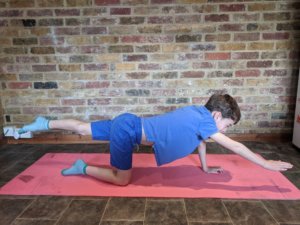
On their hands and knees, encourage your child to reach one arm straight out in front of them in the air. You can challenge them to balance a beanbag or soft toy on the back of their hand to keep it up. Try and hold for 20 seconds.
Now see if they can lift one leg straight out behind them. Try and hold this for 20 seconds.
Can they do an opposite arm and leg at the same time and hold it for 20 seconds? This will challenge their shoulder, elbow and hands stability muscles.
Try the other side.
Now try and lift one leg straight out behind them, holding for one minute this time.
Repeat the above activities again but holding for one minute.
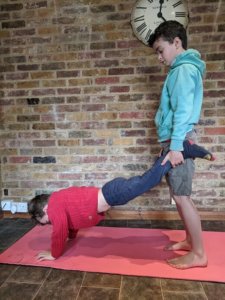 Wheelbarrow walking is incredibly challenging but brilliant for our children. Not only does it strengthen the core but it is also brilliant for shoulder and arm stability – essential for good fine motor skills – which can be problematic for children with DS. As it is so challenging, try to give more support rather than moving down this sequence too quickly as they may give up too quickly if it is far too hard for them. If you can get to number 5 by the time they are 10 years old, they should have fantastic shoulder stability and core which will stand them in great stead for the future.
Wheelbarrow walking is incredibly challenging but brilliant for our children. Not only does it strengthen the core but it is also brilliant for shoulder and arm stability – essential for good fine motor skills – which can be problematic for children with DS. As it is so challenging, try to give more support rather than moving down this sequence too quickly as they may give up too quickly if it is far too hard for them. If you can get to number 5 by the time they are 10 years old, they should have fantastic shoulder stability and core which will stand them in great stead for the future.
Hold your child by their hips with their legs straddling you and their hands on the floor. Move around the floor picking up objects for as far as you can go.
Move your hands down to your child’s knees and walk around the room – picking up objects or playing a matching game or skittles.
If you can, hold your child by their ankles. Make sure they keep their bottom in the air and don’t hang their tummy down. Again find a game to make this more entertaining.
As your child gets stronger you could try to get from one end of the house to another – you can even try going up the stairs.
You could also make an obstacle course to go around.
 Any climbing using hands will be good for hand and shoulder strength and stability. This includes climbing on furniture or up the stairs. The more weight which goes through the arms, the better.
Any climbing using hands will be good for hand and shoulder strength and stability. This includes climbing on furniture or up the stairs. The more weight which goes through the arms, the better.The most challenging activity is hanging on a bar or going along monkey bars. Try getting your child to hang off a door (supervised of course) or your hands if you don’t have access to a bar to hang from.
Advanced Wrist, Hand and Arm Strengthening Activities
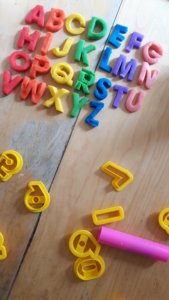 See this ‘Our Home’ video on hand strengthening with playdough – kneading, pulling apart, squashing or wringing the playdough can all be great hand strengthening exercises.
See this ‘Our Home’ video on hand strengthening with playdough – kneading, pulling apart, squashing or wringing the playdough can all be great hand strengthening exercises.
For finger strengthening, try hiding objects in the dough and your child has to manipulate it to get the toy.
a piece of hard card into a head shape, and draw on a face. Your child can clip on clothes pegs to make hair.
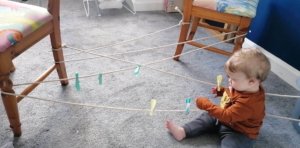
Wrap string around some chair legs and peg pegs to the string for your child to remove.
Do a scavenger hunt. Clip pegs around the house on bits of material, paper, drawer handles etc. Your child can then go around the house or the room (depending on their mobility) to find the pegs and take them off. See this ‘Our Home’ video which shows how to use a tablet to set up a scavenger hunt.
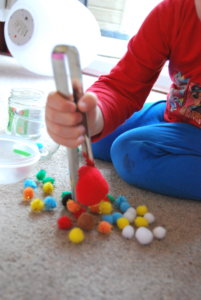
Using home implements can be brilliant for strengthening hands. Give your child some kitchen or BBQ tongs and see if they can pick up items like socks, soft toys or small cushions.
You could set this up as a scavenger hunt too. Take photos of objects your child needs to pick up with their tongs from around the home/room and bring back to you.
For finger strengthening, use tweezers instead of tongs and pick up small items such as dry pasta. See how quickly your child can pick up ten pasta pieces and put them in a bowl the other side of the room.
Collect any spare nuts and bolts (and washers) you have around the house.
Cut out a shape in card (dinosaur, snake, tree – whatever your child would like) and cut small holes or slits into it.
Your child can amuse themselves threading the bolts through the holes and screwing the nuts and washers onto them to make some cool 3D art.
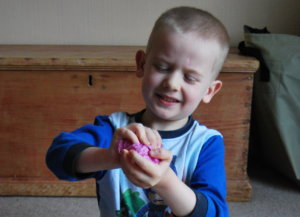
Use a large piece of newspaper and ask your child to scrunch it into the smallest ball they can with two hands.
Now ask them to do it with one hand. The manipulation needed for this will strengthen all the small intricate muscles of the hands.
Squeezing bottles is a lovely way to strengthen fingers. Fill an empty toothpaste tube, ketchup bottle or other container with a spout with liquid or yoghurt and have fun squeezing the liquid out.
Put soft salt/playdough in a plastic bag and make a small hole. Squeezing it out can make a lovely snake of dough.
Squeeze stress balls. Encourage your child to squeeze this or just poke into it with their fingers. See our ‘Our Home’ video for an easy way to make a stress ball at home.

Using scissors is a great way to strengthen hands. Because scissors can be dangerous thought it’s important to make sure our child is supervised while using them.
Start by cutting dough as this teaches the right way to cut. Make a snake out of dough and ask your child to cut it into pieces.
Move on to cutting straight lines on card or paper. As their skills develop you can be inventive with your cutting and draw interesting shapes for them to cut.
See this ‘Our Home’ video for instructions on how to make a Minecraft man chain with straight line cutting.






